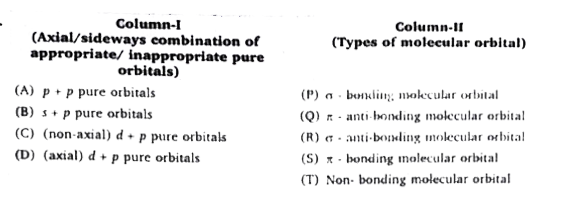Column -I and Column -II contain four entries each. Entries of column-I are to be matched with some entries of column-II. One or more than one entries of column-I may have the matching with the same entries of column-II.  Solution in Telugu
Solution in Telugu
The correct Answer is:A →P; B→Q; C→S; D→R
Step by step video & image solution for Column -I and Column -II contain four entries each. Entries of column-I are to be matched with some entries of column-II. One or more than one entries of column-I may have the matching with the same entries of column-II. by Chemistry experts to help you in doubts & scoring excellent marks in Class 11 exams.
Updated on:21/07/2023Topper's Solved these Questions
- DILUTE SOLUTIONBOOK - NARENDRA AWASTHICHAPTER - DILUTE SOLUTIONEXERCISE - Level 2
1 Videos
- DILUTE SOLUTIONBOOK - NARENDRA AWASTHICHAPTER - DILUTE SOLUTIONEXERCISE - Level 3 - Match The Column
1 Videos
- CHEMICAL EQUILIBRIUMBOOK - NARENDRA AWASTHICHAPTER - CHEMICAL EQUILIBRIUMEXERCISE - Level 2
1 Videos
- ELECTROCHEMISTRYBOOK - NARENDRA AWASTHICHAPTER - ELECTROCHEMISTRYEXERCISE - Level 3 - Subjective Problems
1 Videos
Similar Questions
A saturated solution of XCl3 has a vapour pressure 17.20 mm Hg at 20∘C, while pure water vapour pressure is 17.25 mm Hg. Solubility product (Ksp) of XCl3 at 20∘C is :
View SolutionColumn -I and Column -II contain four entries each. Entries of column-I are to be matched with some entries of column-II. One or more than one entries of column-I may have the matching with the same entries of column-II.

View SolutionCalculate ΔrG for the reaction at 27∘C
H2(g)+2Ag+(aq)⇔2Ag(s)+2H+(aq)
Given : PH2=0.5 bar, [Ag+]=10−5M,
[H+]=10−3M,ΔrG∘[Ag+(aq)]=77.1kJ/mol
View SolutionA solution containing 1MXSO4(aq) and 1MYSO4(aq) is electrolysed. If conc. Of X2+ is 10−zM when deposition Y2+ and X2+ starts simultaneously, calculate the value of Z.
Given: 2.303RTF=0.06
E∘x2+|X=−0.12V,E∘Y2+|Y=−0.24V
View SolutionColumn -I and Column -II contain four entries each. Entries of column-I are to be matched with some entries of column-II. One or more than one entries of column-I may have the matching with the same entries of column-II.

View SolutionColumn -I and Column -II contain four entries each. Entries of column-I are to be matched with some entries of column-II. One or more than one entries of column-I may have the matching with the same entries of column-II.

View SolutionColumn-I and Column -II contains four entries each. Entries of Column-I are to be matched with some entries of Column-II. One or more than one entries of Column-I may have the matching with the same entries of Column-II.

View SolutionEntries of Column-I are to be matched with entrices of Column-II. Each entry of Column-I may have the matching with one or more than entries of Column-II
View SolutionColumn-I and Column-II contains four entries each. Entries of Column-I are to be matched with some entries of Column-II. One or more than one entries of Column-I may have the matching with the same entries of Column-II and select the correct answer using the code given below the Columns
View SolutionColumn-I and Column -II contains four entries each. Entries of Column-I are to be matched with some entries of Column-II. One or more than one entries of Column-I may have the matching with the same entries of Column-II.

View SolutionColumn-I and Column-II contains four entries each. Entries of Column -I are to be matched with some entries of Column-II. One or more than one entries of Column-I may have the matching with the same entries of Column-II.

View SolutionEntries of Column-I are to be matched with entrices of Column-II. Each entry of Column-I may have the matching with one or more than entries of Column-II
View SolutionEntries of Column-I are to be matched with entrices of Column-II. Each entry of Column-I may have the matching with one or more than entries of Column-II
View SolutionEntries of Column-I are to be matched with entrices of Column-II. Each entry of Column-I may have the matching with one or more than entries of Column-II
View SolutionEntries of Column-I are to be matched with entrices of Column-II. Each entry of Column-I may have the matching with one or more than entries of Column-II
View SolutionEntries of Column-I are to be matched with entrices of Column-II. Each entry of Column-I may have the matching with one or more than entries of Column-II
View Solution
